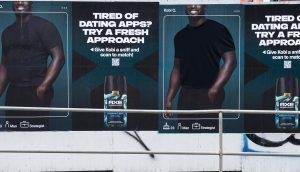While most ARGs are designed to be collaborative, the game just released by Los Angeles-based 42 Entertainment – unleashed to build up to the launch of the new Microsoft Vista Operating System – will be competitive because it targets the very technologically sophisticated.
It kicked off by hijacking the Bellagio Fountain in Las Vegas during the Consumer Electronics Show, projecting the image of a mysterious woman onto the fountain to spark interest in the ARG. Physical clues – from fireworks to sky-writing – will also be deployed in Sydney, Frankfurt and Singapore.
Sites for fans of ARGs had already begun to buzz with speculation about the new game’s existence, based on a mysterious message posted on the news section of MSDN (Microsoft Developer Network) IE Blog. Cybersleuths had already discovered cipher codes, a link to a related website (Vanishing Point), and discovered a countdown clock to Jan. 8 and the location. Blog mentions of further clues include someone receiving related mail, and a video on YouTube which later vanished.
This new genre has been facilitating impressive interaction for big clients, such as Microsoft, Warner Bros. and P&G, by creating elaborate mysteries for participants to unravel with clues planted via websites, phone calls and even live events. The first mainstream ARG, called The Beast, was developed by Microsoft in 2001 to generate hype for the Warner Bros. movie AI. Consumers were drawn into a ‘murder mystery’ narrative via three entry points: a fictitious credit on posters and movie trailers, a phone number in trailers, and a hidden message on select posters. Observant consumers went to their computers and phones to check out the mysterious oddities, and then got sucked into the mystery.
‘We had originally hoped a couple hundred thousand people would get involved. We (ended up with) three million active participants,’ says Jordan Weisman, who led the project while he was Microsoft’s CD, who adds that the frenzy created by this ARG landed a lot of mainstream press coverage by outlets like CNN, Time and USA Today. ‘These three million people created over 300 million impressions for the film,’ he adds.
Following the runaway success of The Beast, Weisman left Microsoft to launch 42 Entertainment, dedicating it to creating ARGs for marketers eager to get their brands noticed by jaded consumers who’ve become oblivious to traditional in-your-face advertising. ‘There was a shift from a push-based marketing system to a pull-based marketing system,’ he notes, explaining the insight behind ARGs. ‘(Marketers) should hide things and whisper and allow the audience to find them.’
42 Entertainment also crafted the offbeat ARG ilovebees, which played out leading up to the launch of Microsoft’s Halo 2. It was a radio documentary based on Halo storylines, delivered via ringing payphones around the world. Players could find clues online, as well as by collaborating with each other via message boards. The effort attracted 750,000 active participants, and another 2.5 million casual players, not to mention mainstream press coverage in the New York Times and on CNN.
And last year, P&G sponsored the ARG Cathy’s Book, which spread out a young adult novel across various websites in pieces. The game also involved cellphone numbers to call for clues, as well as MySpace pages for the lead characters. The diary-style book appeals to teen girls, so P&G tied its CoverGirl and feminine hygiene brands to the various web pages involved in the ARG. The book, written by Weisman and Sean Stewart, CD/story director at 42 Entertainment, was published last fall and landed on the New York Times bestseller list its first week out.
‘We believe that every company has a network that entertainment can be transmitted through – print, TV, packaging. Any outreach you do, each are opportunities to release content,’ says Weisman. ‘You need to be a brand that’s willing to take risks. You’re entering a world encouraging (consumers) to tell stories. You have to honour that deep connection.’ Weisman says the cost to build branded ARGs varies greatly, from hundreds of thousands to millions of dollars depending on the scope.
If crafting an elaborate ARG for your brand isn’t in the cards – or your marketing budget – another way to reach enthusiasts is by advertising on sites dedicated to discussing the genre. One such site is ARGNet, at argn.com, which is based out of La Broquerie, Man. It has an average monthly traffic of about 15,000 unique users, but that spikes to 30,000 at the height of big ARGs like Art of the Heist. About 70% of visitors are from the US, with about 10% from Canada and another 10% from the UK. Advertisers can go through Blogads or Google AdSense to buy space on the site.























